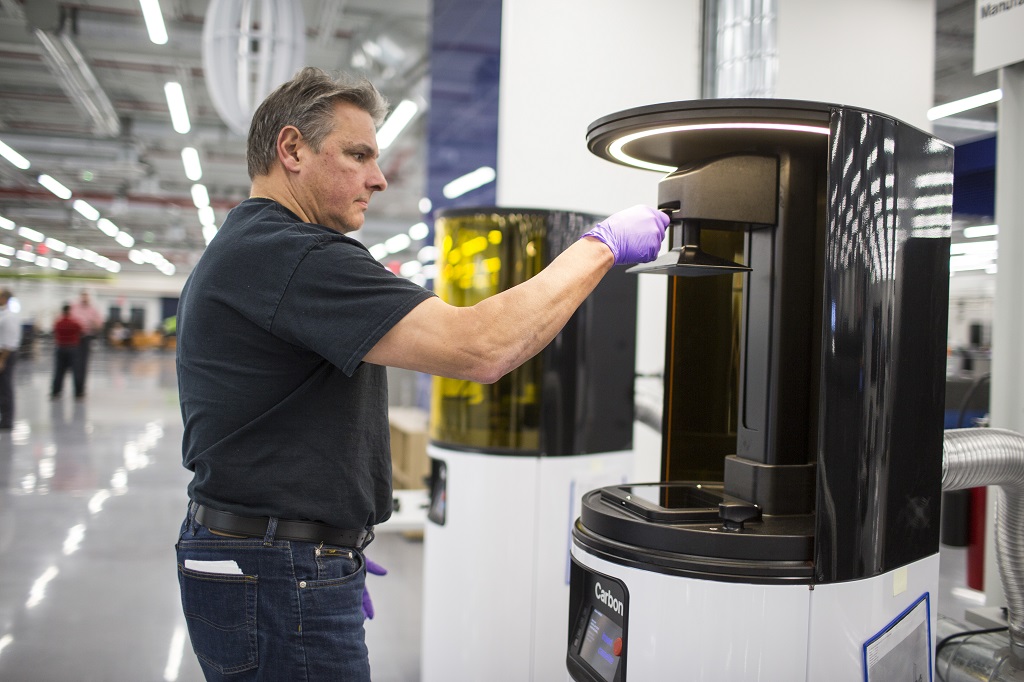![Carbon 3D printers installed at Ford’s Advanced Manufacturing Center [Image: Ford Motor Company]](https://fabbaloo.com/wp-content/uploads/2020/05/carbonatford_img_5eb09ea4126e6.jpg)
Carbon and Ford have expanded their collaboration with a focus on end-use parts.
The automotive company has been working with additive manufacturing since 1988 and was first introduced to Carbon in 2014. In 2015, Ford was announced among Carbon’s early adopters. The relationship has continued, with 3D printers from Carbon among the 90 machines Ford has installed globally — with at least two of these among the 23 at the recently established Advanced Manufacturing Center in Michigan. Today at the Additive Manufacturing for Automotive Workshop at the 2019 North American International Auto Show (NAIAS) in Detroit, the partners announced their collaboration has gone deeper.
At the NAIAS, Ford highlighted what the announcement calls “the first digitally manufactured polymer parts in production for Ford Motor Company.” Among these were two 3D printed brake parts for the Ford Mustang GT500 that were alluded to in last month’s announcement of the Advanced Manufacturing Center, with the electric parking brake brackets shown off at the event. These are joined by end-use parts for other Ford vehicles, including HVAC lever arm service parts for the Focus and auxiliary plugs for the F-150 Raptor.
“We are thrilled to be collaborating with Ford Motor Company and are excited about the many opportunities to leverage the power of digital manufacturing to deliver durable, end-use parts with similar – or better – properties as injection molded parts. The automotive industry shows significant promise for using digital fabrication at scale, and our work with Ford is a perfect example of the kind of innovation you can achieve when you design on the means of production,” said Carbon Co-Founder and CEO Dr. Joseph DeSimone.
The production parts are created with Carbon’s Digital Light Synthesis (DLS) technology and EPX 82 material. The epoxy material has proven durable for the real-world conditions automotive parts endure. Weathering, UV and heat exposure, resistance to fluids and chemicals, and more specific requirements such as flammability (ISO 3795) and fogging (SAEJ1756) were all explored, with the parts withstanding all and passing the requisite performance standards.
The production parts shouldn’t be a surprise, as the automotive industry continues to turn to 3D printing for end-use components. For Ford, it’s also no surprise that these were made with Carbon. In mid-2015, Ellen Lee, team leader in additive manufacturing research at Ford, noted that they were “thrilled” about the results they were seeing with Carbon’s tech.
“The parts we’ve tested are strong in all directions, just like injection molded parts,” she said at the time. “That’s the target we’ve been chasing after for decades.”
Over the last several years, Carbon has been upping its focus on materials development and the move “beyond 3D printing to full-scale digital manufacturing.” Work with highly visible partners toward usable products has shown the team’s dedication to production. This has also been visible through big moves like significant price reductions — which, pleasantly for today’s announcement with Ford, includes EPX 82.
Via Carbon











Charles Goulding and Preeti Sulibhavi consider how two prominent automotive firms, Ferrari and Ford, are using 3D printing.